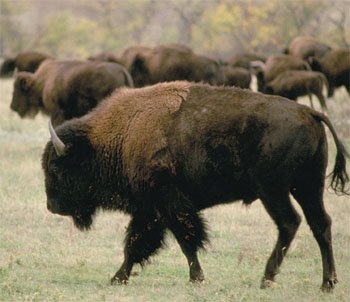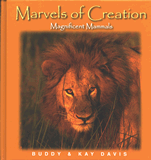American Bison
Also known as the buffalo, millions of American bison once roamed across the American plains.

Also known as the buffalo, millions of American bison once roamed across the American plains. Native Americans depended on bison for their food and clothing, and used the dung—called buffalo chips—as fuel for their fires.
The coat of the bison is dark brown. It is very shaggy at the shoulders, actually consisting of two layers. A thick undercoat traps body warmth. The outer coat, which is shed in the summer, is made of long guard hairs that keep out wind and shed water. The hump on a bison’s back consists of muscle and bone used to support the buffalo’s large head. Both the male and the female have curved horns.
Bison do not have good eyesight, but they have a sharp sense of smell and very good hearing. They can maintain speeds up to 35 miles (56 km) per hour for as long as a half-hour, and are also excellent swimmers. Bison are migratory grazers. Their food is chewed, then swallowed and regurgitated. This is called chewing the cud, but the scientific name is rumination. Like all bovines, the bison does not have any incisors in the roof of its mouth, but it does have a pad and jaw teeth.
Although bison look like overgrown cattle, they are wild animals and can be extremely dangerous. During the breeding season, the bulls are easily provoked, and a cow with a calf will protect it by charging. On the other hand, when a herd feels threatened, the cows will surround the calves, and the bulls will surround the cows.
Adult bison have few enemies, though wolves and coyotes may attack the old, sick, or young. Females mature in two to four years, usually producing one calf per breeding season—July through September. After a gestation period of nine months, calves weigh about 65 pounds (29 kg) when born and are able to stand in a couple of hours.
Early American settlers nearly wiped out the buffalo, reducing the bison population from over 50 million to around 500. After they were put on the endangered species list, the herds increased to over 100,000 bison by 1991.
Today, farms and ranches raise bison for their meat and hide. Because bison and domestic cattle are of the same kind (Bovidae), they can reproduce and their offspring are called “beefalos.” Since bison are very territorial and prefer to stay close to their home range, they are hard to contain in new surroundings. Farmers usually purchase calves because mature bison will break through the sturdiest of fences to return to their original home.
American Bison
Artiodactyla • Bovidae • Bison bison
Height: 6 feet (1.8 m) at the shoulder
Weight: 2,210 pounds (1,000 kg)
Length: 12 feet (3.7 m) from head to tail.
Life Span: 20 years in the wild, up to 40 years in captivity.
Special Design Feature: The coat of the bison is actually two coats.
One is a thick undercoat to trap body warmth and the other has long guard hairs
to keep out the wind and it sheds water.
Did You Know? The American bison is the largest
land mammal on the American continent.
Marvels of Creation: Magnificent Mammals
Brings the world of wild creatures alive in a unique and colorful way with photographs, pages of facts and commentaries.
Browse Kids BookRecommended Resources
- © 2024 Answers in Genesis
- Privacy Policy
- Contact
- About


